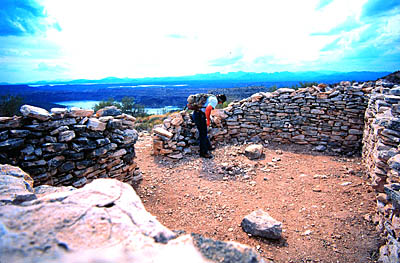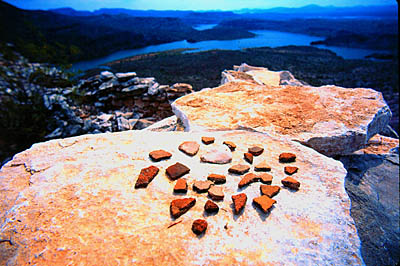This
month I would like to change our focus a bit and visit
a ghost village built by Native Americans. Lifestyles
were very different but the needs were the same, water
and in this case the Agua Fria River were utilized by
both. This Indian fort appears on maps by the name of
Indian Mesa.

Indian
Mesa - Hohokam home atop Indian Mesa. - Photo
courtesy of Mr Quigley Photography.com. |
It
is about 2 miles southeast of Gillette get to this marvelous
ruin, travel north on Interstate 17 to exit 235, Table
Mesa Road. Turn left crossing over the interstate, then
right and follow the dirt road about one mile. Turn
left at the Y and follow this road to the Agua Fria
River. Park at the river. During low-water periods,
it is possible with a 4-wheel drive vehicle to follow
the old jeep road (Old Table Mesa Road) toward Humbug
Creek. The road turns right (west), winding uphill to
a saddle. Be aware, this road is in very poor condition.
Park here.
During
high water periods follow the west side bank on top,
and soon you will intersect Old Table Mesa Road again.
Follow the road to the top of a saddle, and at this
point you will notice a small trail off to your left.
Follow this trail to the top of Indian Mesa. There is
only one access point to Indian Mesa because of its
steep cliffs. This entrance is on the west side of the
Mesa. Carefully climb the remaining 50 or so yards,
and you will be atop the mesa.
Immediately
you’ll be surrounded by stone-walled houses in
very good shape. Indian Mesa is truly a spectacular
Indian ruin. Take your time exploring this area. The
views from Indian Mesa are simply awesome. Be aware
that the cliff edges are unstable; so don’t get
too close to the edge. There are many stone-walled houses
on the mesa, and a few in-the-ground matates. Pottery
shards are scattered all around.
 Indian
Mesa - Pottery shards and views from Indian Mesa.
- Photo courtesy of Mr Quigley Photography.com.
Indian
Mesa - Pottery shards and views from Indian Mesa.
- Photo courtesy of Mr Quigley Photography.com. |
These
ruins probably supported as many as 200 people. The
houses you see were used for sleeping, storage, and
protection during bad whether. The Hohokam spent most
of their time outdoors hunting and gathering. Other
features near the houses include a granary, storage
rooms, and roasting pits. Hohokam people lived as separate
family units here on Indian Mesa. When families grew
too large for their home, part of the group would establish
another residence some distance away. Sometimes when
homes became dirty from being lived in for a long time,
they were abandoned for a new one, allowing nature to
do the housecleaning. After some time, these homes were
reinhabited.
At
Indian Mesa, villagers made pottery by mixing clay they
found along arroyos and sand collected from the Agua
Fria River. To prepare the clay, potters first moistened
it, then set it aside to allow it to age for several
days. Next, the sand was sifted. Then the potters mixed
everything together to form a potter’s clay.